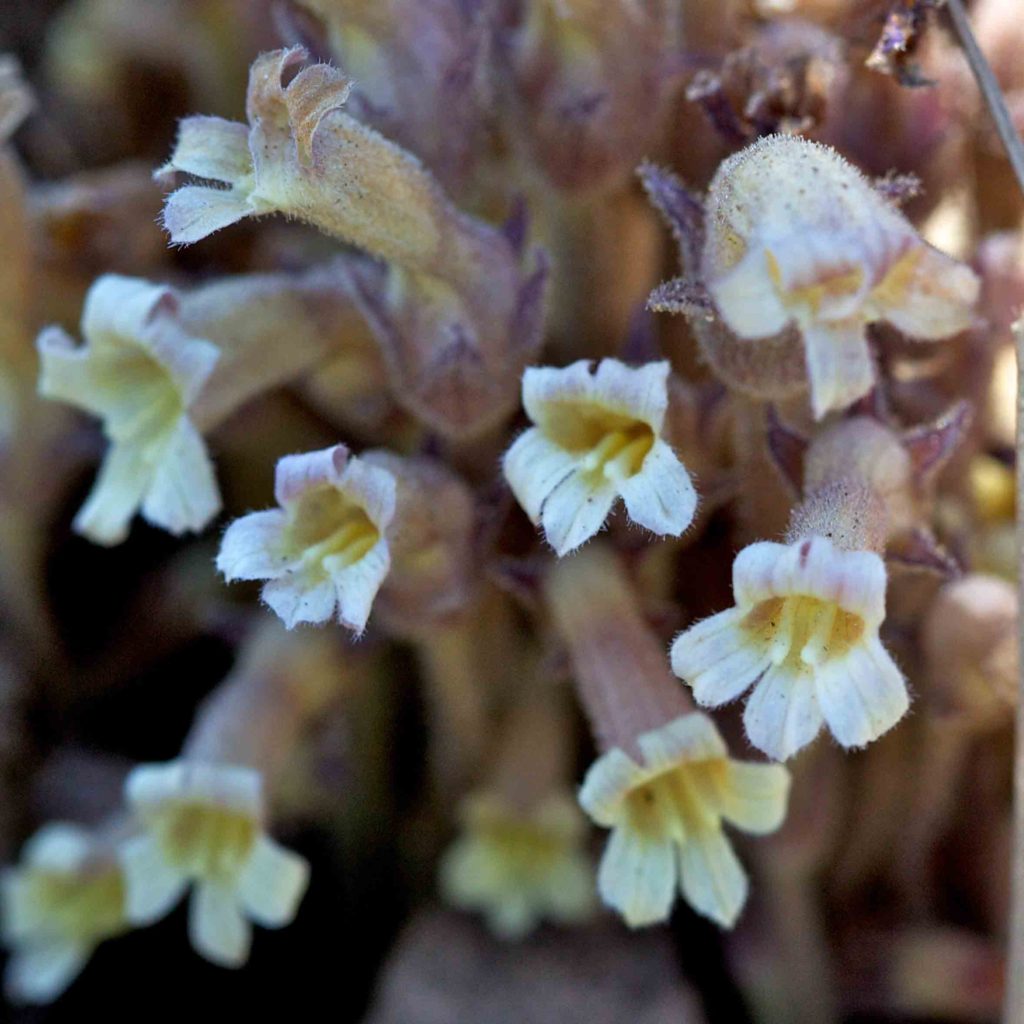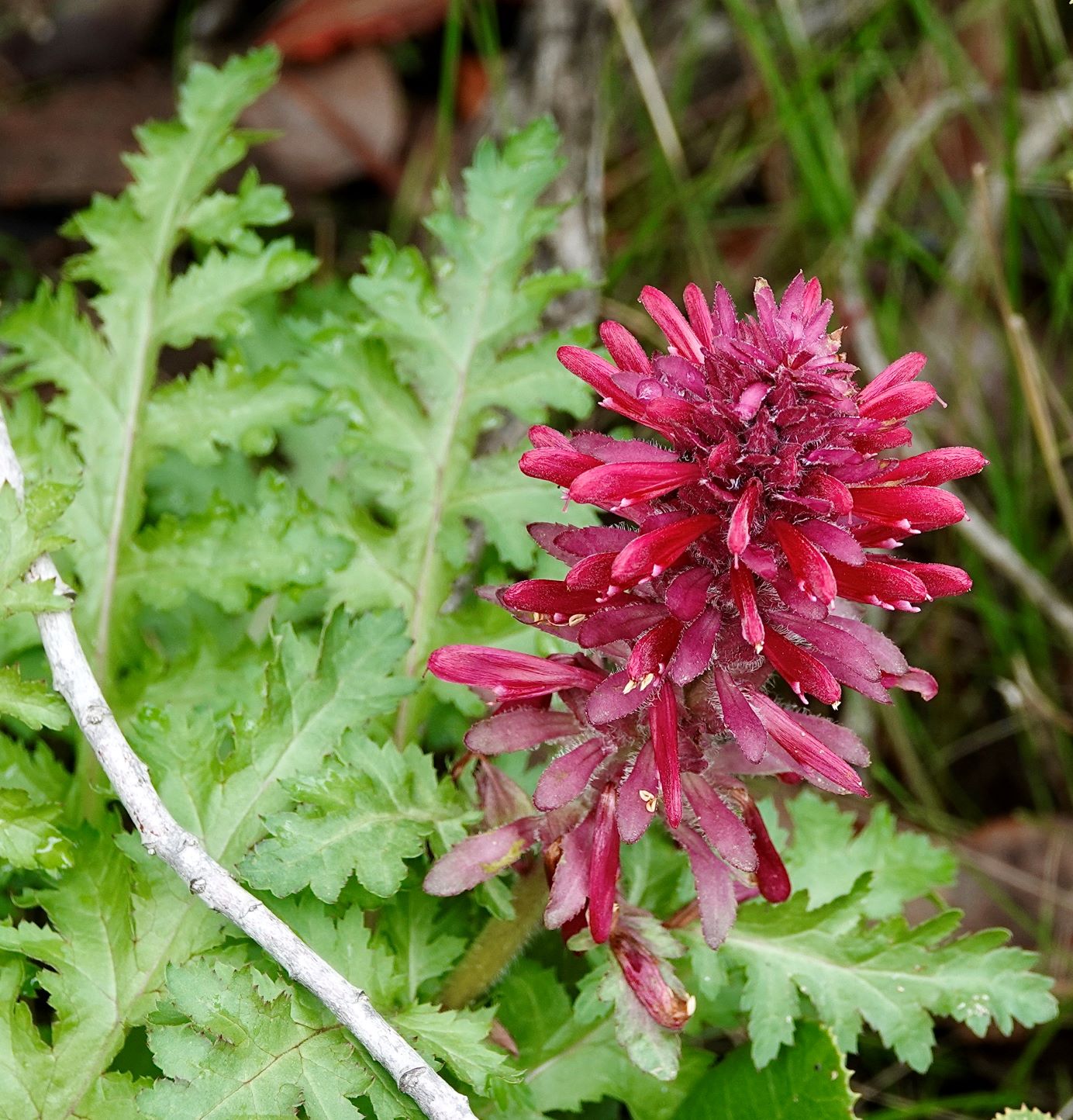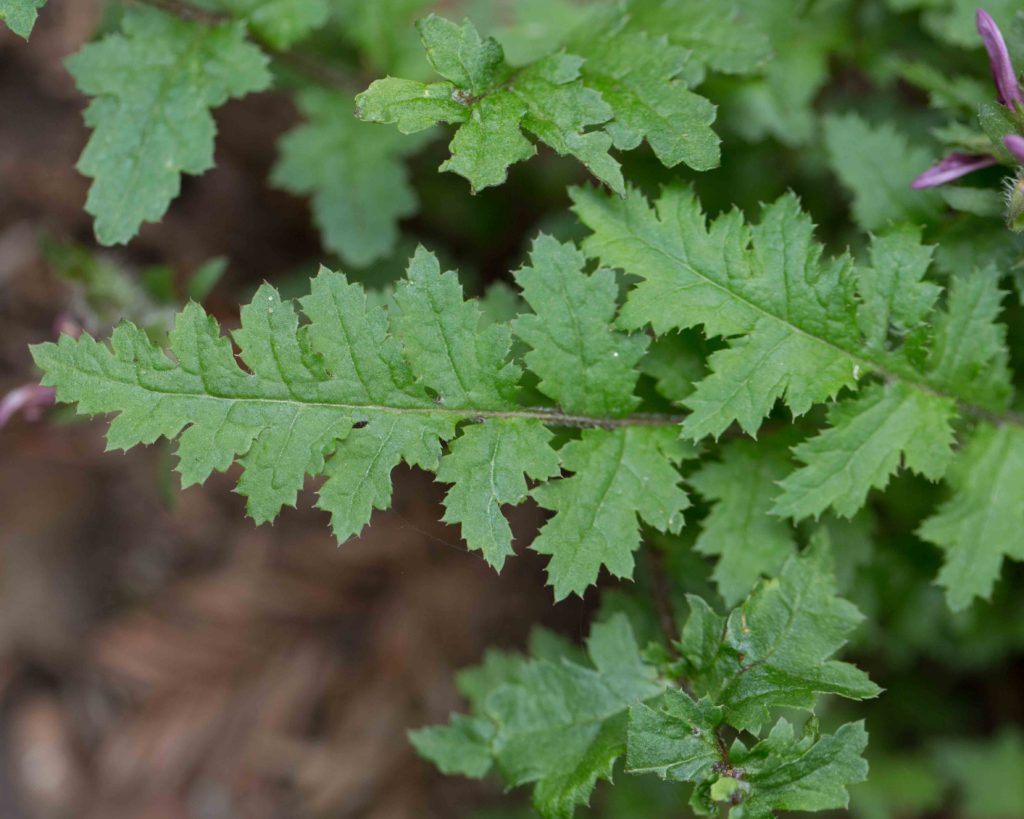Orobanchaceae: Broomrape Family — Various excluding Castilleja
Members of the broomrape family are all root parasites. The Aphyllon (formerly Orobanche) genus is fully parasitic. Its members have no green leaves capable of photosynthesis, therefore they can’t use sunlight for energy. Others, like Castilleja and Pedicularis, are hemiparasitic, meaning that they have photosynthetic green leaves, but also derive some of their nutrients from nearby plants.
Clustered Broomrape – Aphyllon fasciculatum (formerly Orobanche fasciculata)
Blooms:
Apr–June
Plant Height:
5–20 cm
Flower Size:
Small
Origin:
Native
Habitat:
Dry chaparral, parasitic on Artemisia, Buckwheat, Yerba Santa and Bedstraw
Notes:
A true parasite, without photosynthetic leaves. Its flowers have broad, flaring lips and are pinkish to yellow, either on separate stems or densely clustered. Generally found above 600 m. [Note: All native California members of the Orobanche genus have been moved to the Aphyllon genus (see Jepson eFlora Revision 5, December 2017).]
Naked Broomrape – Aphyllon purpureum (formerly Orobanche uniflora)
Blooms:
Apr–July
Plant Height:
3–12 cm
Flower Size:
Small
Origin:
Native
Habitat:
Moist places, parasitic on members of sunflower and saxifrage families
Notes:
A true parasite, without photosynthetic leaves. This has 1-3 beautiful, small bluish-purple flowers, on pedicels 3–12 cm long. Most of the plant’s stem is underground. This species generally has pale purple (occasionally deep violet) to yellowish flowers. [Note: All native California members of the Orobanche genus have been moved to the Aphyllon genus (see Jepson eFlora Revision 5, December 2017). It is now considered that A. uniflora is not found in California and that California plants previously treated as Orobanche uniflora did not belong to that species.]
Chaparral Broomrape – Aphyllon tuberosum (formerly Orobanche bulbosa)
Blooms:
Apr–June
Plant Height:
8–30 cm
Flower Size:
Small
Origin:
Native
Habitat:
Openings in chaparral, parasitic on Chamise
Notes:
A true parasite, without photosynthetic leaves. This is a compact, dense plant, sometimes triangular in outline. Flowers are yellowish to purple, 10–18 mm long. Closeup photographs can give a misleading sense of its true size. The tip of the hiking pole shows how small the plant really is. [Note: All native California members of the Orobanche genus have been moved to the Aphyllon genus (see Jepson eFlora Revision 5, December 2017).]
Mediterranean Linseed – Bellardia trixago
Blooms:
Apr–June
Plant Height:
15–80 cm
Flower Size:
Medium cluster
Origin:
Mediterranean
Invasive?
Yes, limited
Habitat:
Disturbed grassland
Notes:
This is an invasive species, occasionally found along roadsides. At first sight it can be mistaken for a member of the mint family, with its squarish stems and spike-like cluster of flowers. Each flower has a hood-like, pink upper lip. Note the white lower lip, three-lobed with the middle lobe slightly extended. The throat has two distinct ridges. The leaves are coarsely toothed to scalloped, opposite towards the top of the stem.
Bird’s Beak – Cordylanthus rigidus subsp. rigidus
Blooms:
July–Sept
Plant Height:
30–150 cm
Flower Size:
Small
Origin:
Native
Habitat:
Dry slopes
Notes:
A tall, much-branched, almost shrubby annual plant, soft-hairy, and yellow-green or red-tinged. It has small, inconcspicuous white flowers, shaped like a bird’s beak with a U-shaped maroon stripe. There are 5–15 flowers per head, each surrounded by leaf-like bracts. The bracts are lobed in the lower half, with the middle lobe either tapered or blunt and notched.
Warrior’s Plume – Pedicularis densiflora
Blooms:
Feb–May
Plant Height:
6–55 cm
Flower Size:
Medium cluster
Origin:
Native
Habitat:
Woodland, parasitic on Manzanita and other members of the Heath family
Notes:
This plant has toothed bracts and tubular flowers, both colored deep maroon. The basal leaves are somewhat fern-like, starting out reddish but fading to dark green. It is usually found under larger plants, getting shade and nutrients (from the other plant’s roots). It is common in early spring, often found in abundance. Formerly called Indian Warrior. Photos #1-2 by CJH.
Dudley’s Lousewort – Pedicularis dudleyi
Blooms:
Mar–June
Plant Height:
10–30 cm
Flower Size:
Small cluster
Origin:
Native
Rare or endangered?
Yes – 1b.2
Habitat:
Moist open places near streams (Little Sur River)
Notes:
This rare plant has dark green leaves that are pinnately lobed, elliptic-oblong to ovate. The corolla is pink to purplish. Its upper lip forms a narrow hood enclosing the stamens and pistils, and the lower lip is whitish, about half as long as the upper.
Butter-and-eggs or Johnny Tuck – Triphysaria eriantha subsp. eriantha
Blooms:
Mar-May
Plant Height:
10-30 cm
Flower Size:
Small clusters
Origin:
Native
Habitat:
Grassy fields
Notes:
This small plant has spikes of yellow flowers, extending above the purple bracts. Each flower has 5 lobes, the lower 3 bright yellow and inflated into pouches. The upper lobes are smaller and darker, forming a dark point which extends above and beyond the lower petals. The purple stem is hairy, and leaves are 5 cm, narrow with pointed lobes. From a distance, it might resemble scrambled eggs, although ham-and-eggs might be a closer match. Photos by CJH.
Dwarf Owl’s-clover – Triphysaria pusilla
Blooms:
Apr–June
Plant Height:
≤ 20 cm
Flower Size:
Very small
Origin:
Native
Habitat:
Grassy fields
Notes:
This plant can be up to 20 cm tall, but is normally much smaller. The foliage is green, turning reddish-brown. The tiny flowers are almost invisible to the naked eye. But under a hand lens, you will see a pouch, dark red on top, with lower lips also dark red.


































